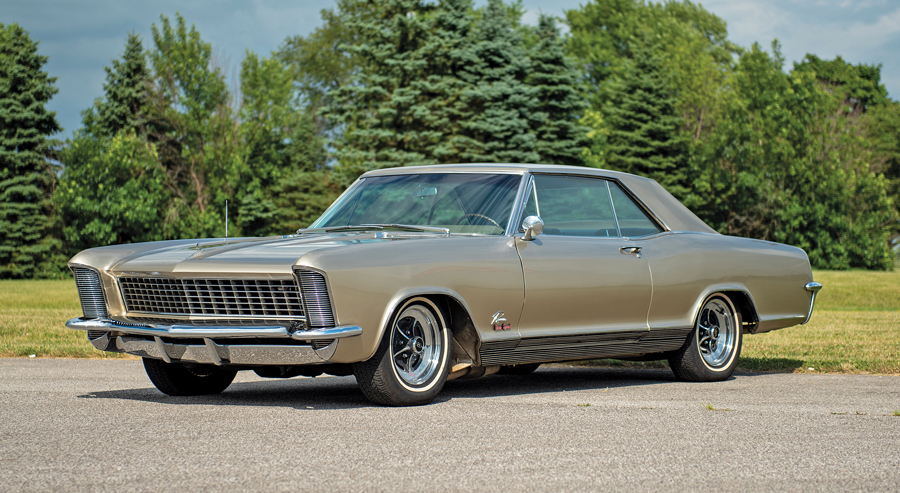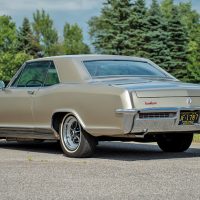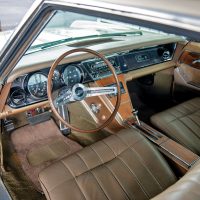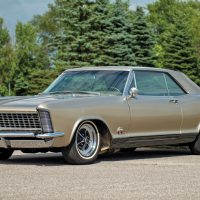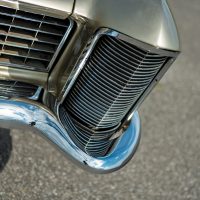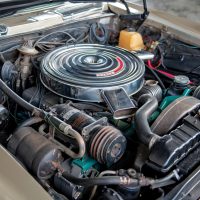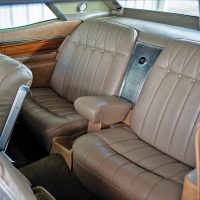- Powered by Buick Super Wildcat V8 engine
- Console-shift automatic transmission
- Air conditioning, power windows, steering and brakes
- Interior features bucket seats and AM/FM radio
SCM Analysis
Detailing
| Vehicle: | 1965 Buick Riviera GS |
| Years Produced: | 1963–65 |
| Number Produced: | 3,354 1965 Gran Sports |
| Original List Price: | $4,636—excluding options |
| SCM Valuation: | $71,500 |
| Tune Up Cost: | $250 |
| Chassis Number Location: | Plate on left front door hinge |
| Engine Number Location: | Crankcase and cylinder block |
| Club Info: | Riviera Owners Association |
| Website: | http://www.rivowners.org |
| Alternatives: | 1965 Ford Thunderbird, 1965 Pontiac Grand Prix, 1965 Oldsmobile Starfire |
| Investment Grade: | B |
This car, Lot 2130, sold for $35,200, including buyer’s premium, at RM Auctions’ Auburn Fall sale held August 29 to September 1 at Auburn Auction Park in Auburn, IN.
Famed Italian designer Sergio Pininfarina called the 1963–65 Buick Riviera “one of the most beautiful American cars ever built.” American designer Raymond Loewy, at the Riviera’s introduction at the Paris Auto Show, said it was the handsomest American production car — except for his Studebaker Avanti, of course.
As dramatic as the Buick Riviera was, it owes its inspiration to the Ford Thunderbird.
Style and luxury
For decades, General Motors was considered the styling leader. However, starting in about the mid-’50s and continuing for the next 15 years or so, Ford’s styling took center stage while the GM suits in the corner offices sat on their hands. The Thunderbird delivered a one-two punch; first as the 2-seater that almost ended the Corvette’s career before it got started, and second as the 4-passenger personal luxury car introduced in 1958. GM did not have a response.
While upper management was complacent, GM dealers and stockholders were not. Neither was GM Design Vice President Bill Mitchell. He had been creating exciting Motorama show cars, and in frustration stated, “They ended up copying our stuff with that ’58 ’Bird while we kept turning out more dream cars!”
In a Special Projects studio, however, the design staff was unofficially working on a stylish design — code named XP-715 — with twin LaSalle grilles on the fenders concealing the headlamps and a conventional grille in between. Mitchell, who was adept at navigating the corporate hallways, found a receptive ear with GM President John Gordon. The question was, who was going to build it? It was envisioned as the LaSalle II, but Cadillac, along with Chevrolet, had full plates. Competition between Oldsmobile, Pontiac and Buick was staged to determine who would build the car.
Buick needed a shot in the arm, as sales had fallen by half a million units between 1955 and 1959. They pulled out the stops, and with an unorthodox move, had their new advertising agency McCann-Erickson give a very convincing presentation. With the new car in hand, Mitchell and crew set out to build the new Riviera, which he visualized as something between a Rolls-Royce and a Ferrari.
The finished product that emerged from Buick designer Ned Nickles’ studio was beautifully styled. It had a sharply sculptured roofline with shear side panels, frameless side-window glass and a low silhouette. The egg-crate grille was reminiscent of Ferrari.
Nailhead power
The Riviera was powered by a 401-ci Nailhead V8 rated at 325 horsepower. For an extra $50, you could get the bored-out 425 that provided an extra 15 horsepower. Leather bucket seats were an option, with vinyl in a choice of three colors as standard equipment. It was priced at $4,333. 40,000 were produced the first year, which met expectations. Tom McCahill wrote that the 53-inch height appeared to be “three inches lower than a trench.”
Little was changed for 1964, although leather seating was no longer available and the 425 V8 was standard with a second 4-barrel available as optional equipment. The 3-speed Super Turbine Drive transmission was also standard.
For 1965, the headlamps were moved from the grille to under the LaSalle fender grilles. They were an engineering nightmare and they frequently failed to close properly — especially in a wet and rainy climate. The styling was cleaned up with the elimination of the rear quarter scoops.
The standard engine in ’65 was the 401 once again, but the Gran Sport option was also available, which featured the 425-ci V8 with twin Carter AFB carburetors. An optional ride package included heavy-duty suspension with firmer springs and shocks and rear track-bar bushings. Buick called the GS “the iron fist in a velvet glove.” The Gran Sport option was a $306 upcharge. Only 3,354 were ordered.
Bargain Buick
The 1965 Buick Riviera GS sold by RM Auctions at their Auburn sale was from the Ed Meurer Collection and was presented with a very limited auction description. The pictures, however, did indicate some paint issues and some minor blistering. There was no listing of options, although it was obviously equipped with air, AM/FM radio and power creature comforts.
The SCM Pocket Price Guide indicates a median value of $71,500, but the five most recent public-auction sales paint a different picture. 1950s and ’60s American cars have been under pressure of late, and the trend of these specific sales emphasizes the overall decline.
In January of last year, Russo and Steele sold a Gran Sport for $96,800 (SCM# 6858069). Barrett-Jackson sold three more during the first four months of 2019 for $66,000, $62,700 and $55,000, respectively. GAA, at their July sale this year, sold a well-restored example for $46,500 (SCM# 6907028). While this sale continues the slide, the car represented an incredible value.
Performance, elegant styling and limited production for less than $40,000. Even needing a respray, that’s a bargain and a half. ♦
(Introductory description courtesy of RM Auctions.)
